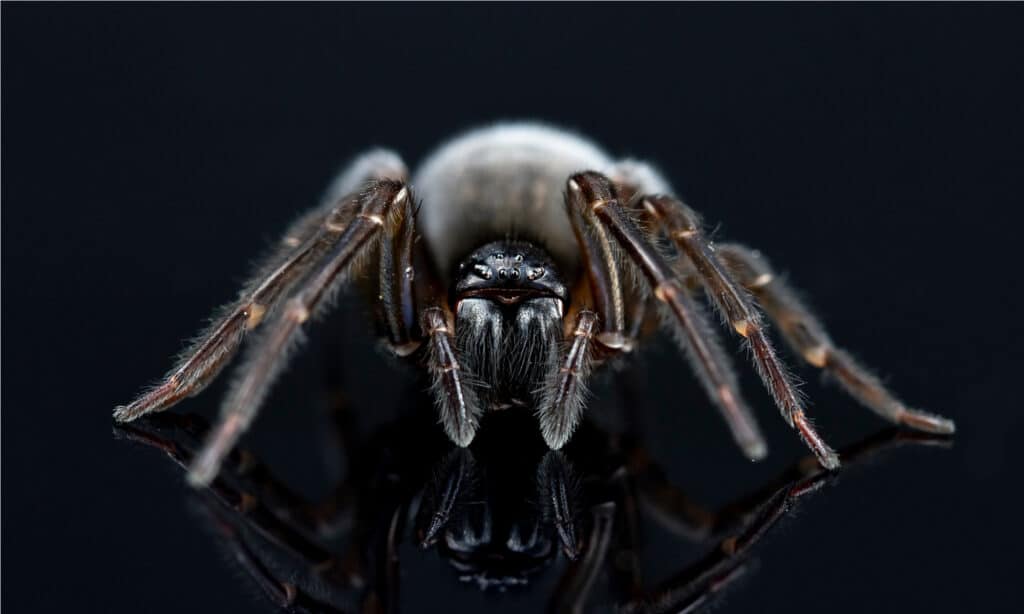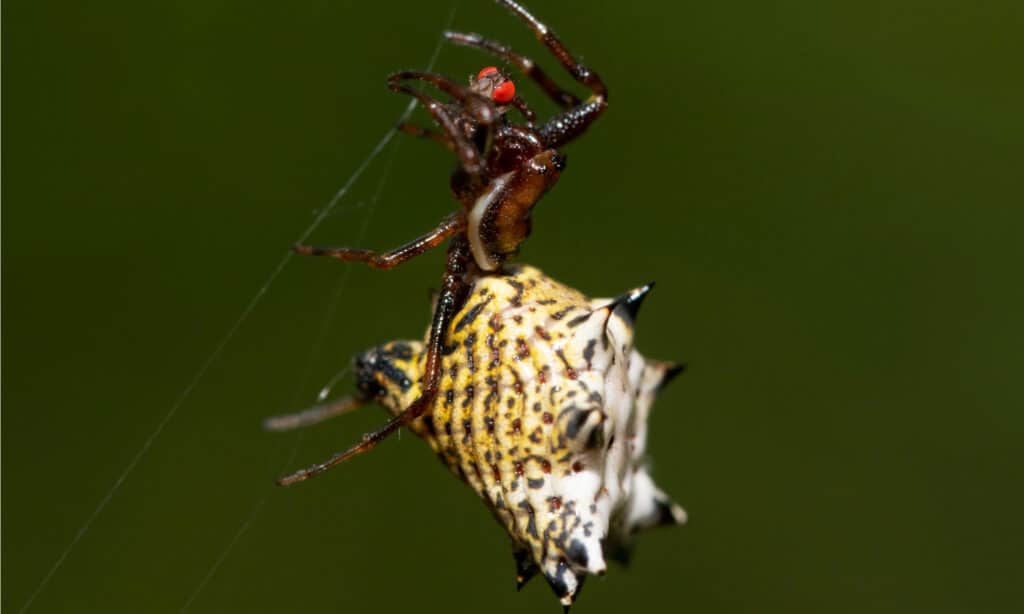When most people think of Connecticut, their minds turn to history. After all, its nickname is The Constitution State, so its no wonder that people think on topics since as politics or government. However, Connecticut is also home to many beautiful locations as well as various plants and animals. In particular, there are many kinds of spiders in Connecticut, from ornate orb weavers to common garden spiders. Today, we’ll discuss 10 different spiders that you can find in Connecticut and how you can identify them.
#10: Black Lace Weaver

The black lace weavers builds a web that has a lace-like appearance.
©IanJHall/Shutterstock.com
Amaurobius ferox, or the black lace weaver, is a member of the family Amaurobiidae. While a native to Europe, you can find these spiders in Connecticut as well as throughout the United States and also New Zealand. It’s commonly found near human dwellings and tends to prefer dark, moist environments such as crevices under stones or walls.
Female black lace weavers measure 11 to 16 millimeters long, while males measure from 8 to 10 millimeters in length. They are predominantly black, but may also appear dark brown or red. Their abdomens are rounded and have pale yellow markings in the shape of a ghoulish face or skull.
Black lace weavers are nocturnal hunters. They spin cribellate webs that have a unique, wooly texture that makes the threads very thin and sticky. Their webs have a lace-like appearance, which is where they get their name.
#9: Dark Fishing Spider
The dark fishing spider is a member of the nursery web spider family Pisauridae. Its range extends from southern Canada to Florida and as far west as the Dakotas. If you hope to encounter one of these spiders in Connecticut you’ll want to spend time near water, although it does also venture into dry woodland areas to hunt.
Female dark fishing spiders can grow to nearly 2.5 centimeters long, while males measure half as large as females. Their bodies range from light brown to grey and their legs are covered in dark spots and spines. They are distinguishable by the dark W-shaped markings on their abdomens.
Dark fishing spiders do not use webs to hunt. Instead, they run across the surface of water or dive below the surface to catch insects and small fish. That said, like other nursery web spiders, females do build silk sacs to hold their young.
#8: Dimorphic Jumper
The dimorphic jumper, maevia inclemens, is a member of the jumping spider family Salticidae. You can find these spiders in Connecticut as well as throughout the eastern half of North America.
Female dimorphic jumpers measure 6.5 to 10 millimeters long and males measure from 5 to 7 millimeters long. Females have a white face and two red or black lines on their abdomens. Meanwhile, males come in two varieties, which is where they get their name; a tufted morph that has a black body and white legs, and a striped morph that has black and white striped legs and a grey abdomen with orange markings.
Dimorphic jumpers are carnivorous predators that hunt a wide variety of insects using their speed and keen eyesight. Due to their small size, their bite is not considered threatening to humans.
#7: Cave Orb Weaver
The next entry on our list of spiders in Connecticut is a rather unusual species known as the cave orb weaver. A member of the long-jawed orb weaver family Tetragnathidae, the cave orb weaver differs both in appearance and behavior compared to most other members of its family.
To begin, cave orb weavers do not have long jaws, legs, or bodies like most other long-jawed orb weavers. Females measure around 8-10 millimeters long, with males measuring only slightly smaller. They typically have dark brown bodies, light and dark brown bands on their legs, and white and dark markings on their abdomens.
Additionally, unlike most other long-jawed orb weavers, cave orb weavers do not build horizontal webs, but rather vertical webs. As their name implies, they frequently build their webs along the ceilings of caves.
#6: Ground Wolf Spider
Trochosa terricola, or the ground wolf spider, is one of several wolf spiders in Connecticut. It is found in myriad habitats and is just as likely to show up outside or inside your home.
Female ground wolf spiders usually measure between 7 and 14 millimeters long, while the males measure from 7 to 9 millimeters in length. They are predominantly brown, with a light brown stripe down the middle of the cephalothorax and two darker stripes on the side. Their abdomens feature a cardiac mark which tends to fade out near the back.
Like other wolf spiders, the ground wolf spider does not build a web to catch its prey. Instead, it relies on its speed and power to hunt down insects, predominantly at night. During the breeding season, female ground wolf spiders will carry their eggs on their back rather than leaving them in sacs on a web.
#5: Variegated Spider
Sergiolus capulatus, also known as the variegated spider, is a species of ground spider in the family Gnaphosidae. It is found throughout the United States, particularly in the eastern half of the country, as well as in Canada.
Variegated spiders get their name from their brightly colored bodies. Their cephalothorax is reddish-brown, while the abdomens are covered alternating black and white stripes. Some believe that their bright colors act as a form of mimicry to make them look like velvet ants, a type of wingless wasp. Females range from 6 to 10 millimeters long, while males average 5.5 to 7 millimeters in length.
Like other ground spiders, variegated spiders are active hunters that do not use webs to catch prey. They are very agile and are able to climb vertical surfaces with ease. Due to their small size, their bite is not considered dangerous to humans.
#4. Garden Ghost Spider
The garden ghost spider, hibana gracilis, is a member of the ghost spider family Anyphaenidae. You can find these spiders in Connecticut as well as throughout the United States and Canada.
Most garden ghost spiders measure between 6 and 12 millimeters long, with females measuring larger than males. They have a long, thin abdomen and elongated spinnerets. Their name comes from their color, which is light brown or yellow with a greenish tint that makes them look spectral or ghost-like. They are sometimes mistaken for sac spiders, which are similar in appearance.
Garden ghost spiders are active, nocturnal hunters. They are most often found outdoors in leafy foliage but will move indoors when it gets cold. Their bite is not usually dangerous but can cause swelling or soreness as well as minor necrosis to the surrounding tissue.
#3. Missing Sector Orb Weaver
Also known as the silver-sided sector spider, the missing sector orb weaver is a member of the Araneidae family. You are unlikely to find them around other spiders in Connecticut, as they are well-known to be solitary.
Female missing sector orb weavers measure 5 to 11 millimeters long, while males are usually around 7 millimeters long. Their abdomens have a silver sheen, which is why they are sometimes called silver-sided sector spiders.
The missing sector orb weaver gets its name from the characteristic missing sector in the top half of its web. Once an insect flies into its web, the missing sector orb weaver will detect the insect via vibrations in the web and then wrap the prey in silk before moving it to its retreat for ingestion. Although it often builds webs near human habitats, it does not often bite people and poses little threat.
#2: Long-Palped Ant Mimic Sac Spider
The long-palped ant mimic sac spider has one of the longest names of all the spiders in Connecticut. A member of the corinnid sac spider family Corinnidae, it is distributed throughout the eastern United States and parts of Canada.
Adult females can reach around 13 millimeters in length, while males range from 3 to 6 millimeters long. They have black abdomens with at least 4 lateral white or light grey stripes.
While the long-palped ant mimic sac spider does not look like an ant it does move and act like one, as it often uses its front legs similar to how an ant uses its antennae. Since it is an active hunter that doesn’t build a web, this behavior likely helps it to get close enough to ants to prey on them. Luckily, it’s only a threat to ants, as its bite is not dangerous to humans.
#1. White Micrathena

©Sari ONeal/Shutterstock.com
(Image description: The white micrathena’s Latin name translates to “headdress” since the spider’s body resembles a wrapped turban.)
The white micrathena, micrathena mitrata, is an orb weaver spider in the family Araneidae. Like most other orb weaver spiders in Connecticut, the white micrathena is a common sight in gardens and parks that have suitable plants it can use to construct its web.
A relatively small species, white micrathenas range in size from 3 millimeters to 11 millimeters long, with males measuring smaller than females. Their Latin name translates to “headdress,” because their abdomens resemble the shape of a wrapped turban. They are predominantly white, with black patches on the abdomen and a black or dark brown cephalothorax.
Like other orb weavers, the white micrathena spins a sticky web that it uses to catch prey. Because it preys on many garden pests and rarely bites humans, many people consider it a beneficial spider to have in the garden.
The photo featured at the top of this post is © Sari ONeal/Shutterstock.com
Thank you for reading! Have some feedback for us? Contact the AZ Animals editorial team.






